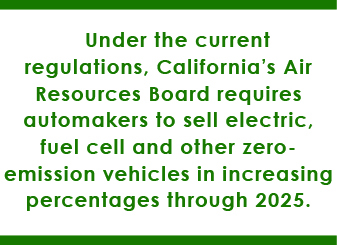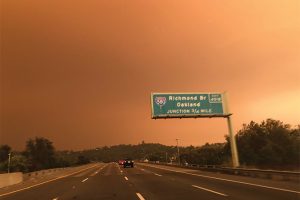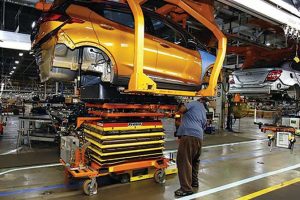By Phil Willon and Tony Barboza Previously published in the Los Angeles Times
Emphasizing that California must stay at the forefront of the fight against climate change, Gov. Gavin Newsom issued an executive order on September 16 to restrict new car sales in the state to only zero-emission vehicles by 2035 and threw his support behind a ban on the controversial use of hydraulic fracking by oil companies.
Under Newsom’s order, the California Air Resources Board would implement the phaseout of new gas-powered cars and light trucks and also require medium and heavy-duty trucks to be zero-emission by 2045 where possible. California would be the first state in the nation to mandate 100% zero-emission vehicles, though 15 countries already have committed to phasing out gas-powered cars.
Newsom did not take executive action to ban the controversial oil extraction method known as fracking but called on the state legislature to do so, setting up what could be a contentious political fight when lawmakers reconvene in Sacramento next year.
Taken together, the two climate change efforts would accelerate the state’s already aggressive efforts to curtail carbon emissions and petroleum hazards and promise to exacerbate tensions with a Trump administration intent on bridling California’s liberal environmental agenda.
“This is the most impactful step our state can take to fight climate change,” Newsom said in a statement released Wednesday morning. “Our cars shouldn’t make wildfires worse — and create more days filled with smoky air. Cars shouldn’t melt glaciers or raise sea levels threatening our cherished beaches and coastlines.”
Newsom said that California’s action will help spur greater innovation for zero-emission vehicles and, by creating a huge market, will drive down the cost of those cars and trucks. According to the California New Car Dealers Association, more than 1.63 million new cars and trucks are expected to be sold in the state in 2020.
Climate scientists and advocates say the world must stop producing gas- and diesel-powered vehicles by 2035 or earlier to keep global warming to tolerable levels. California and other governments worldwide are seeking to achieve carbon neutrality by 2045, and it will take years for vehicles to turn over and be replaced by zero-emission models.
Newsom sharply criticized the Trump administration this month for ignoring the reality of climate change, saying that California’s deadly wildfires, some of the largest in state history, were grim reminders of what lies ahead for the nation if political leaders in Washington don’t take action. Rising temperatures have decimated forests across the West Coast, leaving behind swaths of dead trees to fuel catastrophic wildfires.
“This is a climate damn emergency,” Newsom said during a tour of the charred landscape around the Northern California town of Oroville. “This is real and it’s happening.”
While meeting with Newsom in Sacramento last week, Trump expressed skepticism about the scientific evidence of climate change, saying: “It’ll start getting cooler. You just watch.”
The state has sued the Trump administration to block efforts by the U.S. Environmental Protection Agency to rescind a special federal waiver that permits California to set its own strict pollution controls to improve air quality, the foundation of the state’s aggressive efforts to combat climate change.
While pleased about Newsom’s action on zero-emission vehicles, environmental activists remain skeptical about his actions on fracking. In November, Newsom imposed a temporary moratorium on new hydraulic fracking permits, saying he wanted them to undergo independent scientific review. Since April, however, his administration has issued close to 50 new permits to Chevron and Aera Energy, frustrating environmentalists.
“Newsom is really good at making announcements that sound big, but they aren’t. We can’t let the fact that he’s acting on cars eclipse the fact that he’s still protecting the oil industry,” said Kassie Siegel, director of the Climate Law Institute at the Center for Biological Diversity. “He is the governor of the state at the very center of the climate emergency right now, and he has the political environment here that allows him to think big. If he won’t take strong action that we so desperately need, who will?”
This week, Siegel’s organization threatened to sue Newsom unless he halted all new permits for gas and oil wells in the state, saying the governor has failed to protect the health of vulnerable Californians from pollutants released by the state’s petroleum industry.
Since taking office, Newsom has faced pressure from politically influential environmental groups to ban new oil and gas drilling and completely phase out fossil fuel extraction in California, one of the nation’s top petroleum-producing states.
But the Democratic governor has pushed back, promising to take a more measured approach that addressed the effects on oil workers and California cities and counties that are economically dependent on the petroleum industry.
California has 1,175 active offshore wells and 60,643 active onshore wells. In 2019, the state produced just under 159 million barrels of oil, CalGEM records show. The state’s annual crude oil production has been consistently declining since 1985.

California oil industry representatives have argued that phasing out oil production in the state, which has some of the world’s strictest environmental regulations, would force more oil to be imported by train and tanker ships from countries that do not have the same environmental safeguards. According to the Western States Petroleum Assn., there are more than 26 million vehicles with internal-combustion engines in California.
Cars, trucks and other vehicles are the largest emitters of greenhouse gases in California, accounting for about 40% of the statewide total. Their emissions have been stubbornly creeping upward in recent years. Driving down transportation pollution remains the state’s biggest challenge in achieving its goal of slashing planet-warming emissions to 40% below 1990 levels by 2030.
Under the current regulations, California’s Air Resources Board requires automakers to sell electric, fuel cell and other zero-emission vehicles in increasing percentages through 2025. Electric and plug-in hybrid vehicles accounted for 7.6% of new car registrations in California in 2019.
In 2018, under then-Gov. Jerry Brown, the state set a goal to put 5 million zero-emission cars on the road by 2025. According to auto industry sales data, there were 670,000 zero-emission vehicles sold in California through the end of 2019.
In June, the Air Resources Board adopted the nation’s first sales mandate requiring heavy-duty truck manufacturers to sell increasing percentages of electric or fuel cell models until all new trucks sold in California are zero-emission by 2045.
But efforts to completely phase out gas-powered cars have not gained traction. Three years ago, Brown directed the state’s chief air quality regulator, Mary Nichols, to look into stepping up the state’s timetable. But so far, her agency has only floated the idea of banning gas-powered vehicles in the state’s congested areas. And legislation lawmakers introduced in 2018 to require all cars registered in the state be zero-emission by 2040 didn’t move forward.
Some local governments have set their own zero-emission vehicle targets, which they are unlikely to achieve without the backing of tougher regulations. A “Green New Deal” plan by Los Angeles Mayor Eric Garcetti, for example, aims to increase the percentage of zero-emission vehicles to 25% by 2025, 80% by 2035 and 100% by 2050.
Phil Willon and Tony Barboza
Previously published in the Los Angeles Times
This story appears in Issue 4 2020 of the Los Angeles Dealer Magazine.









